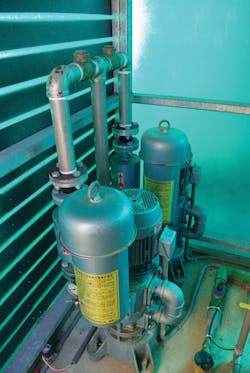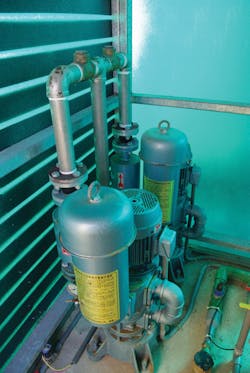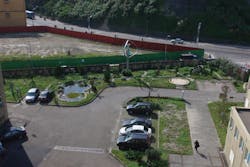Rainwater harvesting involves the collection of precipitation for a wide range of agricultural, commercial and domestic uses, from watering landscapes to flushing toilets. When properly collected and treated, the method can also be employed to harness a valuable source of potable water.
Andrew Williams reports.
With the exception of a few high profile examples, most notably the Star City project in South Korea, rainwater harvesting systems have tended to be small-scale. However, as a new initiative in Hawaii begins to explore how the technique can be used on a larger-scale, there are some signs that this may be about to change.
For several years, people on many of the remote islands of Hawaii have relied solely on harvested rainwater for all their potable and non-potable needs. It is estimated that nearly one-third of the homes in Hawaii County (commonly known as the 'Big Island') currently use catchment water for their own private use.
Alongside these household-level systems, the Hawaii State Department of Health also regulates four large-scale 'public water systems' that depend on and serve rainwater as their primary source of water - including two national parks, one military camp, and one 'youth challenge' facility.
In an effort to build on this growing area of expertise, a new partnership between the University of Hawaii's Sea Grant Program and the American Rainwater Catchment Systems Association (ARCSA) has been established to "advance the understanding and adoption of such sustainable water practices across the islands".
During August, the University hosted a successful two-day workshop on O'ahu to provide training in all aspects of rainwater harvesting - and the partnership has ambitious plans to conduct research and outreach on practices and policies "to ensure Hawaii's coastal communities have access to clean, fresh water now and for generations to come".
According to Matthew Gonser, an extension agent for the University of Hawaii Sea Grant College Program, rainwater harvesting has a big role to play in the future provision of potable water, not just in Hawaii but worldwide.
"The technologies and competencies exist today, and will only improve in the coming years - rainwater harvesting is not a new practice, it is something that went out of vogue, and is now coming back with improved technologies and capacities," he says.
While costs may be a factor in some cases, Gonser's view is that it is likely that the greatest strides will need to be made in the 'public desire' for water catchment, through increased education and awareness of its benefits and necessity.
"Like wastewater reuse, this is a social science and policy issue where those involved in the research, design, and maintenance fields can play a more active role. In that sense it is also a business and economics proposition," he says.
Taiwan
Meanwhile, in Taiwan, a recently established green building rating system stipulates that rainwater harvesting to supplement water supplies is required for all new public buildings - and private buildings must also install rainwater harvesting systems in order to attain green building certification.
"In the last year, rainwater has been officially recognised as an alternative water resource and listed in the water law by the [Taiwan] Water Resources Agency," says Chao-Hsien Liaw, Professor in the Department of Harbor and River Engineering, National Taiwan Ocean University and President of the International Rainwater Harvesting Systems Association (IRCSA).
In the course of his work, Liaw explains that he has designed many rainwater harvesting systems for schools and government buildings, as well as a museum, an exhibition hall and public attractions.
"We have implemented rainwater harvesting systems in Taipei city zoo for over ten years. Nowadays, more than 50% of potable water is [provided] by rainwater," says Liaw.
Other interesting examples of wide-scale adoption include those in Gansu Province, China, where more than three million Shuijiao (water cellars) have been used to provide people with drinking water, and Bangalore and Chennai in India. Each installed several thousand rainwater harvesting structures to replenish groundwater and supplement surface water sources.
Large-Scale Adoption
According to Srikantaiah Vishwanath, a rainwater harvesting consultant based in Bangalore, supportive government policies can be very helpful in driving large-scale adoption. He points out that, when rainwater harvesting became mandatory for new buildings, as well as old buildings beyond a certain plot size, a "flourishing entrepreneur driven market" was created in the city.
"Plumbers were trained and were willing to offer services competitively," he says. "Large-scale innovation of filters happened with more than 40 filters in the market, employment was created for plumbers and well-diggers and there was a boom in the water economy."
For Vishwanath however, the single biggest challenge is behaviour change - and he warns that it is difficult to convince people that rainwater can be drunk, "especially if it has not been a cultural practice".
"The other challenge is the up-front costs of these systems. While maintenance cost can be negligible over the lifetime of the system, the upfront costs of installation deter people from adopting it. Subsidized mains water is another problem as it makes rainwater harvesting economically unattractive if people are connected to mains systems," he adds.
Meanwhile, Liaw argues that, although the technology already exists, the main barriers to large-scale adoption are "financial feasibility and operation and maintenance".
From a cost perspective, he also agrees that it takes a long time to recover the cost of installing a rainwater harvesting system and he believes that the establishment of a management committee in charge of education, planning, operation and maintenance is the 'cornerstone' to successful implementation.
He also adds that the removal or storage of large quantities of water from a given location may be disallowed by the authorities because it decreases the amount of water available downstream.
"This principle means that rainwater may be viewed as a public resource rather than [belonging] to the owner of the land on which the rain falls," he says.
Fear of the Unknown
According to Billy Kniffen, national director and education program chairman at the American Rainwater Catchment Systems Association (ARCSA), fear of the unknown represents another challenge to large-scale adoption - at least in the US.
"We capture rainwater in lakes and rivers and use it in potable systems but once you put it in a container the fear factor goes up. Or else the big manufacturers, consultants and authorities either do not want to change, they fear it will take time and money or take money away from them and there is not the necessity to do anything as of yet in most of the US," he explains.
"Necessity is the driver. Also it takes lot of roof and storage to supply needed amounts, double piping, fear of cross connection and costs involved. If it is critical - as in many developing countries - it could be implemented now. But smaller systems are easier to install and costs are spread out," adds Kniffen.
Looking Ahead
From a technological perspective, Kniffen believes that microfiltration systems designed to remove cysts "easily and without much maintenance" will be a big help - and "could be implemented easier with large systems"
Meanwhile, Jesper Skadhauge, global product manager for domestic water supply at Grundfos also points out that, although it is "more problematic" to install rainwater harvesting systems as retro-fit, it is still "absolutely feasible".
"However, if buildings are designed for rainwater usage from the start it is very easy. The main driver for these systems is still legislation as water is still a relative low-cost resource in many parts of the developed world," he says.
"One additional, and equally significant, benefit of these systems is their ability to buffer heavy rainfall. This buffer-effect means that the municipal rainwater system is not being peak-loaded as it otherwise would, reducing the need for expensive expansion," adds Skadhauge.
For Liaw, green building policies and similar government mandates, which he says are 'gaining in popularity around the world,' will continue to fuel the large-scale implementation of rainwater harvesting systems.
In the future, he argues that integrated rainwater management systems, which necessitate the design of large-scale systems, will become the 'new wave' of rainwater harvesting. Moreover, although it has not yet been developed specifically for rainwater treatment, he also sees much promise in emerging membrane technology."
More broadly speaking , Gonser says that an extensive review of measures taken by other US states and territories has revealed "progressive legislation" that uses an array of strategies and tools to encourage or mandate rainwater catchment practices for both non-potable and potable uses.
Specific strategies and tools include the creation of state-wide standards for rainwater harvesting - including health and safety standards for collection and treatment of water intended for drinking, cooking, or bathing - as well as tax incentives and rebates to purchase equipment and install catchment systems and supporting grants for pilot-projects
"Rainwater catchment practices raise concerns of water quality and public health. That said, at the heart of the practice is a concern for water quantity, whether as conservation measure or for survival," says Gonser.
"It is a challenge for any government body to add monitoring protocols and training-services to already burdened staff and budgets, but our research provides some examples, including economic tools, that may be of use for the state and county governments of Hawaii or elsewhere, if water catchment practices and uses are identified as a priority," he concludes.
Andrew Williams is a freelance correspondent for WWi magazine.






